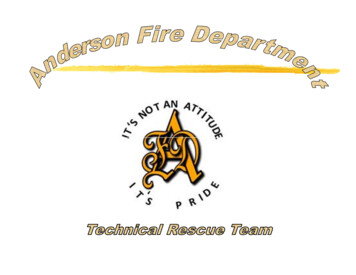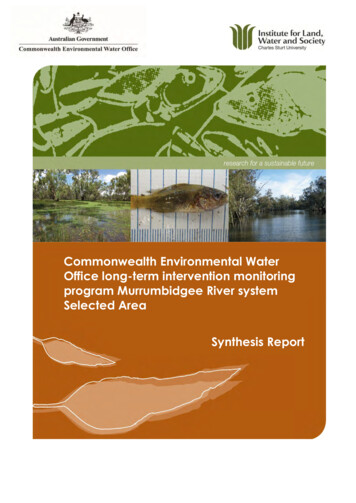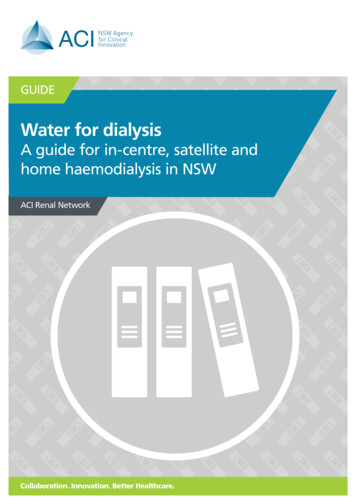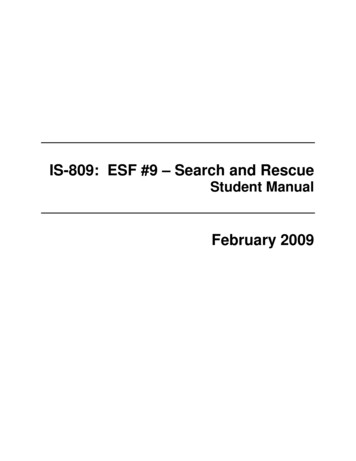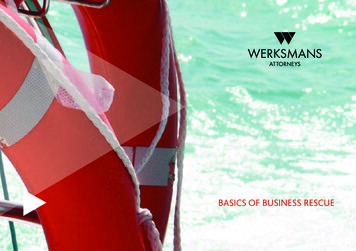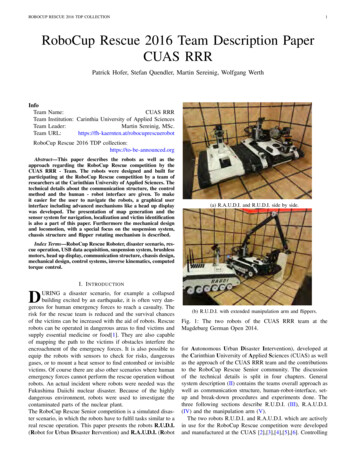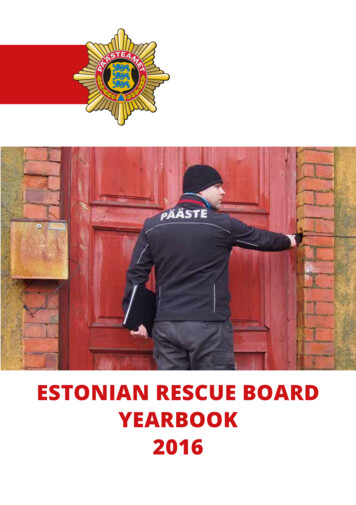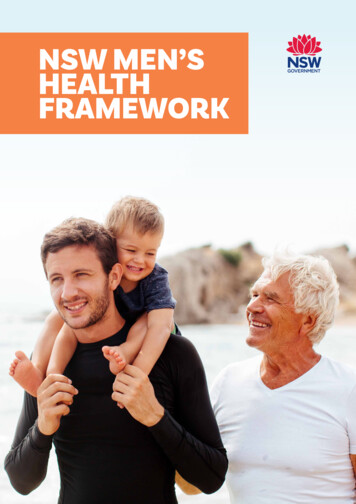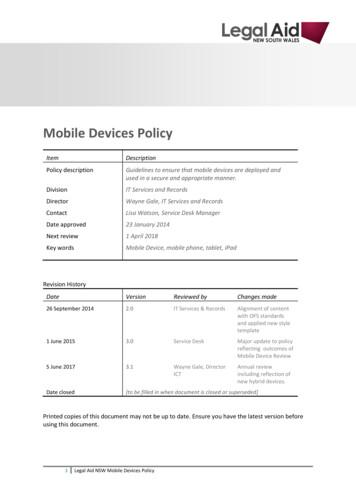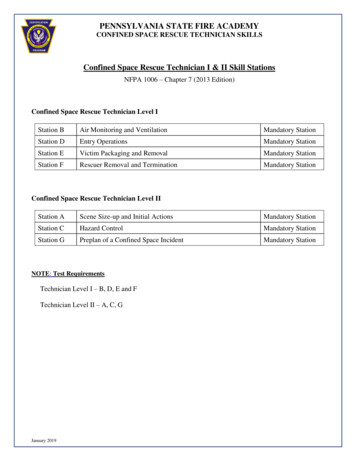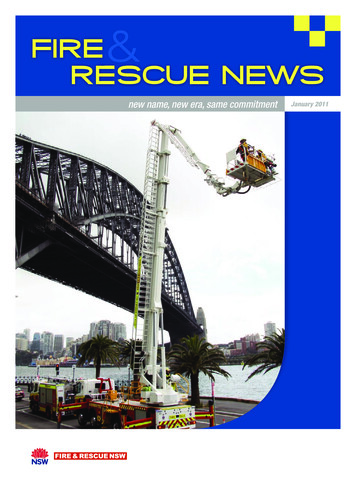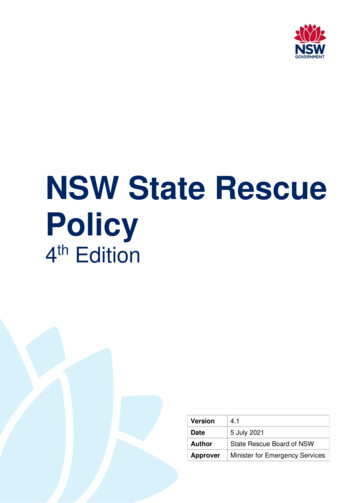
Transcription
NSW State RescuePolicy4th EditionVersion4.1Date5 July 2021AuthorState Rescue Board of NSWApproverMinister for Emergency Services
AuthorisationThe New South Wales State Rescue Policy has been prepared by the State Rescue Board incompliance with the State Emergency and Rescue Management Act 1989 (as amended) and ishereby submitted for the approval of, and issued by, the Minister for Emergency Services.RecommendedCommissioner Stacey Tannos ESMChairState Rescue BoardApprovedNSW State Rescue Policy 4th Edition Version 4.1DOC056877– 5 July 2021Page 2 of 88
Amendment ListProposals for amendment or addition to the contents of the State Rescue Policy are to be forwardedto:The Executive OfficerState Rescue BoardGPO Box 5434SYDNEY NSW 2001Amendments promulgated are to be certified in the under mentioned amendment sheet whenentered.VersionDate endorsed by the State Rescue Board1. 3rd EditionVersion 3.12. 3rd EditionVersion 3.230 November 20113. 3rd EditionVersion 3.321 May 20124. 3rd EditionVersion 3.47 March 20135. 3rd EditionVersion 3.54 December 20146. 3rd EditionVersion 3.6December 20167. 4th EditionVersion 4.08. 4th EditionVersion 4.114 November 2018Out of Session May 2020 and17 February 2021NSW State Rescue Policy 4th Edition Version 4.1DOC056877– 5 July 2021Page 3 of 88
Table of ContentsChapter 1 – General Introduction.7The State Rescue Board of NSW .7The SRB's Function .7Board Membership .7Responsible Minister .7Secretariat .8Definitions .8Rescue Units .12Rescue Crews - land .13Rescue Crews - flood .14Rescue Crews – marine .14Rescue Vehicles .14Rescue Vessels .15Vessel Registration .15Use of Helicopters in Rescue .16Body Recovery Tasks .16Land and Waterway Search and Rescue Operations .16Marine Search and Rescue Operations .17Search and Rescue Coordination Centres .18Marine Radio Bases .18Debriefings and Reviews .19Responsibilities for Rescue Scene Clean Up.19Recording of Images and Video .19When is it appropriate to record images and video? .20Ownership of Images and Video .21Public Display of Images and Video .21Using Images and Video for Training .21Storage of Images and Video .22Statements to the Media and Public .22Complaints .22Chapter 2 - Response Policy .24General Principles .24Unavailable/Available .25Interim Response Arrangements .25Medical Emergency Access .26Response Policy - Land .26Call-Out.27Unavailable due to existing deployment .27Call-Off .27On Scene Control .28Calls for Additional Rescue Units .28Response Policy - Marine .28Overall Coordination .28Call-Out.29Notification .29NSW State Rescue Policy 4th Edition Version 4.1DOC056877– 5 July 2021Page 4 of 88
On Scene Control .30Unavailability .30Marine Radio Monitoring .30Call-Off .30Suspension .30Response Policy - Flood .31General Principles .31Flood rescue framework.31Control – task areas .31Activation, communication and coordination .32Non established areas of operations .32Established Flood Rescue Area of Operations .32Call-off .33Response Coordination Disputes .33Chapter 3 - Accreditation.34General .34The Principles .34Pre-accreditation Policy .35Safety Requirements and Rescue Operator Physical Pre-requisites .35Infectious Disease Policy .35Critical Incident Support Policy .35Specialist Rescue .35Underwater Search and Recovery .35Cross Border Rescue Operations.36Support Units .36Rescue Identification .36Risk Management for Land Rescue Service Provision .36General Land Rescue .37Vertical Rescue .37Marine Rescue.37Flood Rescue .38Competencies and Equipment lists .38Equipment lists.38Competencies .39Chapter 4 - Accreditation Procedures .40General .40Land Rescue Accreditation Procedures.40Pre-Accreditation .40Full Accreditation .41Marine Rescue Accreditation Procedures .41General .41Marine Rescue Vessel Requirements .42Pre-accreditation .42Accreditation Process .43NSW State Rescue Policy 4th Edition Version 4.1DOC056877– 5 July 2021Page 5 of 88
State Rescue Board Marine Inspection Team .43Flood Rescue Accreditation Procedures .44Pre-Accreditation .44Full Accreditation .44Chapter 5 – Operational Capability Inspections .46Operational Capability Assurance Framework .46Annual Reporting Requirements .47Chapter 6 - Committees .48Policy Advisory Committee .48Duties of the Committee.48Local and Regional Rescue Committees .48Membership – Local .48Membership – Regional .49Functions and responsibilities – Local and Regional Rescue Committees .49Meetings .50Minutes of Meetings .50Resolution of Problems .50Marine Advisory Sub-Committees .51Chapter 7 – Rescue Training and Exercises .52General .52Flood Rescue .52Rescue exercise funding .53Attachments .54Attachment A - Flood Rescue Framework .54Attachment B - Flood Rescue Activation Process .55Attachment C - Minimum Equipment List - General Land Rescue (GLR) .56Attachment D - Minimum Equipment List - Road Crash Rescue (RCR) .59Attachment E - Minimum Equipment List - Vertical Rescue (VR) .61Attachment F - Minimum Equipment List - Marine Rescue (MR) .63Attachment G - Minimum Equipment List - Flood Rescue (FR) .70Attachment H - Competencies - General Land Rescue (GLR) .72Attachment I - Competencies - Road Crash Rescue (RCR) .73Attachment J - Competencies - Vertical Rescue (VR) .74Attachment K - Competencies - Marine Rescue (MR) .75Attachment L - Competencies - Flood Rescue (FR) .83Attachment M - SRB Annual Report Template - Rescue Agency .85Attachment N - SRB Annual Report Template - Regional Rescue Committee .86Attachment O - SRB Medical Emergency Access Protocols.87NSW State Rescue Policy 4th Edition Version 4.1DOC056877– 5 July 2021Page 6 of 88
Chapter 1 – General IntroductionThe State Rescue Board of NSW1.01The State Rescue Board of NSW (the SRB, the Board) is a Statutory Body constituted undersection 42 of the State Emergency and Rescue Management Act 1989 (the SERM Act).The SRB's Function1.02The SRB's principal function is to ensure the maintenance of efficient and effective rescueservices throughout the State. The SRB will carry out its responsibilities through the Headsof the agencies which provide accredited rescue units and the NSW Police Force, who areresponsible for the coordination of rescue within the State.1.03The SRB is generally responsible for the development and promulgation of rescue policy,the setting, promulgation and monitoring of standards of training, and for providing advice onequipment levels for all rescue units in the State. The SRB is also responsible forrecommending to the Minister the accreditation of units to undertake those forms of rescuefor which the Board has decided that accreditation is required.1.04At the direction of the Council of Australian Governments, the Productivity Commission is toreport annually on the efficiency of road rescue in all States and Territories. The SRBcontributes to this report and the agencies are to provide information as required.Board Membership1.05The SRB is chaired by a Member of the Board who is appointed by the Minister. The SRBcomprises of the following senior officers:a) State Emergency Operations Controllerb) Member of the NSW Police Force Senior Executive Servicec) Chief Executive Officer, NSW Ambulanced) Commissioner, Fire & Rescue NSWe) Commissioner, NSW State Emergency Servicef)Commissioner, NSW Rural Fire Serviceg) Commissioner, NSW Volunteer Rescue Association Inc.h) Commissioner, Marine Rescue NSW, andi)the Heads of other volunteer rescue agencies approved by the Ministerand may vary depending on agency priorities.Responsible Minister1.06The SRB is responsible to the Minister administering the SERM ActNSW State Rescue Policy 4th Edition Version 4.1DOC056877– 5 July 2021Page 7 of 88
Secretariat1.07The SRB is supported in the execution of its function by a Secretariat in Resilience NSW.Definitions1.08Accredited means formally recognised units as having a particular status or beingaccredited to conduct rescue activities as authorised.1.09Accreditation means formal approval by the Minister to undertake rescue in NSW.1.10Area of Responsibility means boundaries used to define specific geographic areas wherean emergency services agency has the authority to plan and conduct operations.1.11Authorised means those authorised by emergency services agencies to perform specifictasks.1.12Combat agency means the agency identified in the State Emergency Management Plan(EMPLAN) as the agency primarily responsible for controlling the response to a particularemergency.1.13Command means internal direction of the members and resources of an agency in theperformance of the organisation’s roles and tasks (by agreement and in accordance withrelevant legislation). Command operates vertically within an organisation.1.14Confined space means an enclosed or partially enclosed space that:a) is not designed or intended primarily to be occupied by a personb) is, or is designed or intended to be, at normal atmospheric pressure while any person isin the spacec) is or is likely to be a risk to health and safety from:i. an atmosphere that does not have a safe oxygen level, orii. contaminants, including airborne gases, vapours and dusts, that may cause injuryfrom fire or explosion, oriii. harmful concentrations of any airborne contaminants, oriv. engulfmentbut does not include a mine shaft or the workings of a mine.1.15Control means the overall direction of the activities, agencies or individuals concerned. Forthe purpose of this policy, authority for control may carry with it responsibility for tasking otheremergency management agencies in accordance with the needs of the situation. Controlrelates to the situations and operates horizontally across organisations.1.16Coordination means the bringing together of agencies and individuals to ensure effectiveemergency or rescue management but does not include the control of agencies andindividuals by direction.1.17Currency means the process that recognises member’s skills, training and capabilities,captured via operational activity or skills maintenance, as determined by the agency.1.18Domestic animal means an animal that has been domesticated by humans so as to live andbreed in a tame condition and depend on humankind for survival.NSW State Rescue Policy 4th Edition Version 4.1DOC056877– 5 July 2021Page 8 of 88
1.19Flood Rescue means all rescue activities in a relatively high water level which overtops thenatural or artificial banks of any part of a stream, river, estuary, or dam, and/or local overlandflooding associated with drainage before entering a water course, and/or coastal inundationresulting from super-elevated sea levels and/or waves overtopping coastline deficiencies.Any vehicle or pedestrian access way is deemed to be an artificial bank.Swiftwater Rescue encompasses rescue from canyons and waterways where swiftwaterflowing within the banks is the norm. Many recreational activities such as rafting, kayakingetcetera take place in these environments.Flood Rescue and Swiftwater Rescue are operational different. However, as the trainingcompetencies and the qualifications received for completion of training are the same forIn Water Flood Rescue and Swiftwater Rescue, this Policy references In Water andSwiftwater Flood Rescue collectively as ‘In Water Flood Rescue’. This includesarrangements for dispatch and coordination, accreditation and training competencies.There are five levels of Flood Rescue:Flood Rescue AwarenessFlood Rescue Awareness is not an accreditation. The training package, which is providedthrough the NSW State Emergency Service (NSW SES), provides a basic understandingand awareness of generic flood water hazards and associated risks and simple actions whichcan be taken to assist the victim without entering flood waters. The methods involved areTalk, Throw (released) and Reach. These methods include the operator yelling or signallingto the victim to provide assurance or throwing the victim an unconnected object such as arescue tube or portable flotation device.Land BasedLand Based Flood Rescue provides support to On Water and In Water Flood Rescueoperations. Accreditation is not required, however personnel should be trained in LandBased Flood Rescue. The methods involved are Reach, Wade and Throw (held). Thesemethods are undertaken from the shore and include reaching to the victim with a ladder orthrowing a connected object such as a rope or portable flotation device.On WaterAccreditation is required for On Water Flood Recue. The method undertaken is Row(powered vessel). This method involves reaching the victim by powered vessel where thereis a low likelihood of the operator entering the water.In WaterAccreditation is required for In Water Flood Rescue. The method undertaken is Go. Thismethod involves the operator entering the flood waters to reach the person by swimming orusing a raft or unpowered vessel to reach the victim.Over WaterNo accreditation is required for Over Water Flood Rescue. The use of professional helicoptercrews to rescue person/s from flood water is at the direction of the NSW Police Force RadioOperations Group Rescue Coordinator (ROG RCO) or NSW SES Incident Controller.Note: 1.20 sets out when specific agencies are responsible for coordinating flood rescueoperations.NSW State Rescue Policy 4th Edition Version 4.1DOC056877– 5 July 2021Page 9 of 88
1.20Flood Rescue Area of Operations (FRAO) means the boundaries used to define specificgeographic area(s) where the NSW SES have the authority to coordinate and control floodrescues. The NSW SES Incident Controller is the authority that establishes a FRAO. AFRAO may be established when an actual or imminent flood occurrence endangers orthreatens to endanger the safety of persons or animals and a significant and coordinatedresponse is required.The NSW Police Force is responsible for coordinating flood rescue response and fordetermining priorities of action taken in flood rescue operations in the geographic areasoutside of the established FRAO.1.21Flood Rescue Cell in the Australian Inter-service Incident Management System (AIIMS), aflood rescue cell means the area responsible for flood rescue coordination and tasking. Inthe AIIMS structure it comes under the ‘Operations’ functional area but may have directcommunication with the Incident Commander.1.22Flood Rescue Controller (FRC) means the person appointed by, and subject to, thedirection of the NSW SES Incident Controller to be responsible for determining the extent ofthe flood rescue site, establishing control of the flood rescue operation, controlling the ‘onthe ground’ response to the flood rescue and determining the priority of actions to effect theflood rescue. In the absence of an appointment, the Team Leader of the first arriving FloodRescue Team will assume the functions of the FRC until an appointed FRC arrives on scene.The FRC may be appointed within a Flood Rescue Team from any organisation engaged bythe NSW SES for the purpose of conducting flood rescue response within a declared FRAO.During flood rescues, including in an established FRAO, the senior police officer at the sceneworks in collaboration with the FRC.1.23General Land Rescue (GLR) means the capability and capacity to undertake all rescueactivities involving the safe removal of persons or domestic animals from actual or threateneddanger of physical harm. A GLR unit has the skills and equipment required to undertake roadcrash rescue, agricultural, animal, domestic and industrial rescues and is trained in UrbanSearch and Rescue Category 1.1.24Industrial and Domestic Rescue (IRDR) means the capability required to gain access toand extricate entrapped casualty/ies from a range of industrial and/or domestic incidentswhile minimising the potential for further injury and preserving the integrity of evidence.Industrial Rescue (IR) involves the safe removal of persons who have had an accident inthe workplace such as factories, warehouses and building sites. It involves disentanglementfrom machinery and extrication from heavy machinery such as cranes. Rescue of occupantstrapped in elevators and escalators is also included.Domestic Rescue (DR) – involves the rescue of occupants trapped in household settings.This includes such things as children with fingers in drain plugs, removal of rings, andindividuals who are incapable of leaving their home due to ill health.1.25Land Search and Rescue (LANDSAR) refers to the coordination of Land Search andRescue for the provision of life saving assistance to people in distress and imminent dangerof loss of life.1.26Marine Rescue (MR) means a rescue performed on open, enclosed or inland waterwayswhere there is a threat.NSW State Rescue Policy 4th Edition Version 4.1DOC056877– 5 July 2021Page 10 of 88
1.27Marine Rescue unit means one or a combination of Marine Rescue Vessels and/or a Searchand Rescue Coordination Centre or Marine Radio Base.1.28NSW SES Incident Controller means the individual responsible for the management of allincident control activities across the FRAO.1.29Operating procedures means a set of step by step instructions on how to carry outoperational activities.1.30Powered vessel means any vessel powered by a
The Executive Officer State Rescue Board GPO Box 5434 SYDNEY NSW 2001 Amendments promulgated are to be certified in the under mentioned amendment sheet when entered. Version Date endorsed by the State Rescue Board 1. 3rd Edition Version 3.1 2. 3rd Edition Version 3.2 30 November 2011 3. 3rd Edition Version 3.3 21 May 2012 4. 3rd Edition Version 3.4
